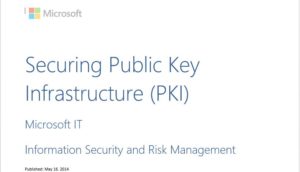<p>Public Key Infrastructure (PKI) is used as a building block to provide key security controls, such as data protection and authentication for organizations. Many organizations operate their own PKI to support things like remote access, network authentication and securing communications.</p>
<p>The threat of compromise to IT infrastructures from attacks is evolving. The motivations behind these attacks are varied, and compromising an organization’s PKI can significantly help an attacker gain access to the sensitive data and systems they are after.</p>
<p>To help enterprises design PKI and protect it from emerging threats, Microsoft IT has released a detailed technical reference document - “<strong><a href="/controlpanel/blogs/posteditor.aspx/<strong>http:/aka.ms/securingpkidl</strong>">Securing Public Key Infrastructure</a></strong>.” <a href="/b/security/archive/2014/06/11/new-guidance-for-securing-public-key-infrastructure.aspx">Read more</a></p>








